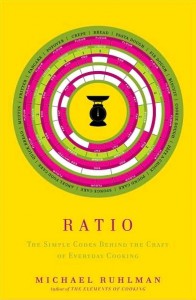Editor’s note: this post is the second part of a series. The first part reviewed a beginner’s book, New Best Recipe.
So you can make dinner without needing to follow a recipe to the letter. When you look at a recipe, instructions like “until properly cooked” no longer scare you. You can look at a recipe and have a pretty good idea whether or not you will like it before you cook it. Congratulations, you’ve made it to intermediate. Now how do you get better? Well, you can continue to follow recipes. You can continue to experiment and put an assortment of ingredients in to a pan together, and I recommend you do, but if you want to make the next leap, you need a whole lot more “how” in your vocabulary.
 What I found I was missing to get to the next level was understanding the basics of recipes where the ingredients or process were essential. Sure, you can make a sauce by throwing some things in the pan and cooking things in approximately the right order, you can get a lot better at that through practice too, but you can’t bake a cake like that. I couldn’t, through osmosis, decode the structure of bread or pasta the same way I could a stir fry. Even more frustrating, certain recipes seemed to be grossly inconsistent with variable methods and variable results. While I could look at a recipe for a lamb stew and have a good idea how it would turn out, raisin scones were a mystery. This book turned out to be the key to unlocking those riddles.
What I found I was missing to get to the next level was understanding the basics of recipes where the ingredients or process were essential. Sure, you can make a sauce by throwing some things in the pan and cooking things in approximately the right order, you can get a lot better at that through practice too, but you can’t bake a cake like that. I couldn’t, through osmosis, decode the structure of bread or pasta the same way I could a stir fry. Even more frustrating, certain recipes seemed to be grossly inconsistent with variable methods and variable results. While I could look at a recipe for a lamb stew and have a good idea how it would turn out, raisin scones were a mystery. This book turned out to be the key to unlocking those riddles.
Ratio gives you the building blocks of dozens of popular dishes, expressed through the ratios of the ingredients. You could almost stop at the cover, a detailed diagram of ratios for common dishes like pasta, bread, or cake, but that would be selling this book short. This book dives in to how. It’s less a recipe book and more an architectural diagram. Forget learning a recipe for dark chocolate cake with raspberry filling and butter cream icing, let’s learn how to make a cake, the essential item, and be free to adapt as we see fit.
The book starts with a discussion of the scale as the ideal measuring tool because of its certitude. A cup of flour is not a cup of flour as it turns out. If you don’t believe me, go get a measuring cup and spoon flour in to it until it’s full. That’s a cup, right? Well, maybe. Now push the flour down, pack it tight and continue filling. You’ll be surprised at how much more flour you can add. Fortunately, an ounce of flour is always an ounce of flour. So using a scale gives us both a precise measurement and a common unit to define our ratios.
This book is definitely baking heavy, where the ratios are so much more important than, say, a curry, but there’s a decent swath of recipes. The focus lies, unsurprisingly, in dishes that require some level of precision; exactly the type of thing The New Best Recipe won’t teach you how to improvise.
If that’s enough to get you interested in the book, the index is the last piece of information you need, explaining exactly what you’ll learn:
- Doughs: Bread, Pasta, Pie, Biscuit, Cookie, pâte à choux
- Batters: Pound & Sponge Cake, Angel Food Cake, Quick Cakes, Crepe
- Stocks: Chicken, Veal, Beef, Fish, & Vegetable Stock; Clear Soups; Consommé
- Thickening with Starch: Roux, Beurre Manié, Slurry Meat: Sausage, Mousseline, Brine
- Fat Based Sauces: Mayonnaise, Vinaigrette, Hollandaise
- Custards: Custard, Crème Anglaise, Chocolate Sauce, Caramel Sauce
This book allowed me to start experimenting with a whole new class of recipe, things I felt I was missing the expertise to make, an expertise I wasn’t even sure how to attain. But it turns out, it’s not that hard. All you really need is a good explanation of the building blocks and at this point in your cooking, building blocks should be enough for you to create something delicious of your own.
Filed under reviews
Tagged: three books for every kitchen

Great review, I just bought this book a few weeks ago and I love it. It’s great to have the why with the how. Sometimes I just read it purely out of enjoyment rather than actually looking to cook something that moment.
As an avid cooking enthusiast, i feel deeply inclined to comment on how inspirational this book is. Thank youuuuuuuuuuuuu